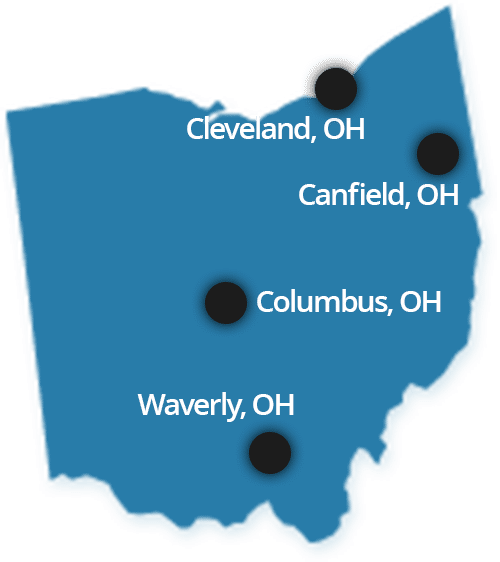Construction is one of the most dangerous industries in Ohio and the United States. Although transportation-related incidents are responsible for the majority of workplace fatalities, construction injuries are right behind, with 14% of workplace fatalities caused by slips, trips, and falls and another 14% caused by contact with an object or equipment.
But one of the surprising risks construction workers in Ohio are facing today is an increased chance of dying from an opioid overdose. In fact, Ohio construction workers are seven times more likely to die from the opioid epidemic than workers in other local industries.
Why? Let’s take a look.
Ohio Opioid Deaths Among Construction Workers
The latest opioid abuse statistics come from an analysis by the Cleveland Plain Dealer, which included records from more than 12,000 opioid drug overdose deaths in Ohio between 2010 and 2016. The average opioid death rates for all Ohio workers was 3.73 per 10,000 workers.
Per 10,000 workers by industry, here are the local fields with the highest opioid death rates:
- Construction: 27.03 deaths per 10,000 workers
- Fishing, farming, and forestry: 23.92 deaths per 10,000 workers
- Cleaning and maintenance: 8.67 deaths per 10,000 workers
- Installation and repair: 7.13 deaths per 10,000 workers
- And these are the Ohio industries with the lowest opioid death rates:
- Educators and librarians: 0.38 deaths per 10,000 workers
- Physical and social scientists: 0.56 deaths per 10,000 workers
- Legal occupations: 0.65 deaths per 10,000 workers
- Business and finance: 0.65 deaths per 10,000 workers
Although most Ohio opioid deaths are from heroin or fentanyl, according to the Plain Dealer analysis, “it’s clear many started with a prescribed painkiller, one deceptively marketed as safe.”
The Opioid Crisis: Working through the Pain
Due to their dangerous jobs, Ohio construction workers may become injured more easily at work. They may need to be prescribed strong painkillers, but sometimes those painkillers can take a dangerous turn. They’re too potent, they can be highly addictive, and they may be overprescribed. Perhaps they’re not gotten from a doctor in the first place, but obtained from a friend who offers to share pain medication, over-the-counter or prescribed, with someone in extreme pain. On a construction site, that exchange might be even more common and the pills more powerful.
Here are a few reasons for the large rate of Ohio opioid deaths among local construction workers, from the Plain Dealer analysis:
- Repetitive work can cause extreme physical wear and tear on the worker’s body over time. This can lead to injuries including chronic back pain, shoulder, or knee pain.
- Workers in any field want to reduce the amount of sick time they take. Those in construction may be tied to working more during specific seasons or when the jobs are available, so getting sick or injured often isn’t an option. Many construction jobs don’t even offer sick time. Enter: prescription painkillers.
- Painkillers became overprescribed over the years due to deceptive marketing and they are far more addictive than advertised. For example, drug makers told doctors when OxyContin came on the market that it had an addiction rate as low as 1% — but it was closer to 12%.
- The Ohio Bureau of Workers’ Compensation sees three times as many on-the-job injury claims from construction workers compared to other fields. More than 80% of Ohio construction workers’ injuries in 2010 were treated with narcotics, many of them opioids or semi-synthetic opioids. The following year, the BWC found that 8,000 Ohio workers were prescribed “potentially addictive amounts of opioids” in reviewing its records; it stopped covering OxyContin as a first choice for painkillers in 2012 and later began limiting doses of other opioids and requiring prescription reviews every few months.
But what sort of damage has happened since then?
The Opioid Crisis: A Comparison Needs to be Made
To get a full picture of the opioid crisis among Ohio construction workers, the BWC should compare the number of injured workers who were prescribed addictive painkillers with the number of injured workers who later died from overdoses. A BWC spokeswoman told the Plain Dealer that it has not done that.
Although standards for prescribing painkillers have changed in recent years — in 2016, injured workers who were overprescribed opioids dropped to 4,100, the BWC says — it may be too late for some workers. Those who could no longer get what they needed out of a prescription painkiller years ago may have turned to illicit drugs. And nearly three in four injured construction workers in Ohio are still receiving prescriptions for narcotic painkillers today.
Although the BWC began offering an 18-month addiction treatment program in October 2016, fewer than 10 injured workers had received treatment from the new program more than a year later. Meanwhile, more than 275 Cleveland-area laborers, electricians, carpenters, roofers, and other construction workers have died of a heroin or opioid overdose since 2010. Five hundred construction workers died statewide just in the last year.
Another recent study by the Midwest Economic Policy Institute estimated that the number of Ohio opioid deaths among construction workers was more than double that of the next-highest state in the Midwest — Illinois. Opioid deaths among construction workers also “cost Ohioans $2 billion in lost production, lost family income and other costs such as health care in 2015.”
One of the coauthors of the study, Jill Manzo, notes:
“Injury rates are 77 percent higher in construction than other occupations, and the financial incentive to get back to work before their bodies are healed is leading many down a path than can ultimately lead to abuse and even death.”
Sadly, it only takes a few days to get addicted to strong opioid painkillers. Gary Franklin, medical director for the Washington State Department of Labor and Industries, told the Plain Dealer: “If someone is on opioids for more than three months, it’s almost too late.”
How to Get Help with an Opioid Addiction
At least 14 Ohioans die every day from a drug overdose. A new 12-point plan, Recovery Ohio, was outlined by Ohio Attorney General Mike DeWine in October 2017 to help combat the opioid epidemic, focusing on prevention, treatment, and expanded tools for law enforcement. For their part, drug companies must contribute to paying for treatment and education because of the creation in the “culture of overprescribing,” DeWine said during a press conference earlier this year.
“As a result of their misleading doctors, there have been thousands and thousands of deaths. We can’t bring the people back who died. But we can hold these drug companies accountable and make them pay,” DeWine said.
If you are struggling with an opioid addiction, you are not alone. For addiction services providers in Cuyahoga County, visit the Ohio Behavioral Health Directory online and take the first step toward getting the treatment you deserve.
Plevin & Gallucci Fights to Hold Drug Makers and Distributors Accountable in Ohio
Cleveland personal-injury firm Plevin & Gallucci is fighting on behalf of local governments to hold manufacturers and distributors accountable and put an end to the opioid epidemic. Plevin & Gallucci has filed lawsuits on behalf of Cuyahoga, Lorain, Lake, Trumbull and Jefferson counties, with more to come. To learn more, visit our press release: Cuyahoga County Files Suit Against Opioid Manufacturers and Distributors; Plevin & Gallucci to Serve as Local Counsel.
You may also be interested in:

